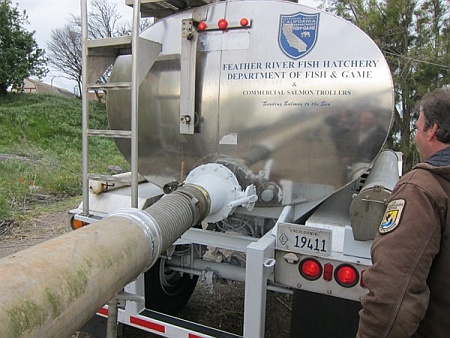California looks to trucking to aid salmon migration
California wildlife agencies are turning to trucks to move some 30 million young Chinook salmon hundreds of miles to the Pacific Ocean because record droughts have left California rivers too low for natural migration.
Four climate-controlled trucks were the first convoy of the migration effort, each hauling 130,000 three-inch smolts from a federal hatchery 180 miles north of San Francisco to San Pablo Bay where they will be held in pens to acclimate before being released into the ocean.
“Water conditions, because of the drought, are going to be horrible for the fish,” said Harry Morse of the state Fish and Wildlife Department. “Depending on how far those fish have to go, the longer they must travel through the system, the higher the losses.”
The fish transport effort is the latest in a series of emergency steps that state and federal authorities are rushing into place as reservoirs ebb one-third below normal and farmers idle thousands of acres. Governor Jerry Brown has called for a voluntary 20 percent cut in water use and many areas have declared mandatory restrictions. More than 800 wildfires have broken out since Jan. 1, three times more than usual, according to state records, and smog in Los Angeles is worse without winter rains to clear the air.
The hatchery fish that typically migrate through the Sacramento River Delta to the sea are key to the state’s $1.5 billion commercial and recreational fishing industry, according to the Nature Conservancy. Fish released now will be part of the population that can be harvested in a few years.
The Pacific Fishery Management Council, which helps set fishing seasons, predicted in early March that more than 630,000 fall-run Chinook salmon from the delta are in the Pacific Ocean now. That’s less than last year but more than enough for a normal commercial fishing season, the council said.
The lack of rainfall means that the Sacramento River will prove too shallow and too warm for the tiny fish to survive the 200 to 300 miles of river and tributaries some must navigate to reach the Pacific.
Convoys of four to seven trucks daily will make the trip from the federal hatchery for 22 days. In all, 12 million juvenile fish will be taxied from there, along with 18 million raised in four state-owned hatcheries. When released from the pens, the tiny fish will migrate to the ocean and mature. They return to the rivers as an adult to spawn.
“Our 2016 fishing season may be riding on the survival of the fish in these trucks,” said Roger Thomas, chairman of the Golden Gate Salmon Association, an advocacy group based in Petaluma, California. “We know that fish trucked around dangers lurking in the rivers and delta survive at much higher rates than those released at the hatcheries.”
While the state usually trucks some of its hatchery fish to the ocean, this year’s haul will be about three times more than normal. It costs California taxpayers $1,500 a week to rent the tanker trucks, and the state expects to spend $150,000 on trucking, including fuel costs, Morse said.
“This is a Herculean effort between state and federal agencies to try to stave off a fisheries disaster,” said Stafford Lehr, fisheries branch chief at the California Department of Fish and Wildlife. “Our fish right now are undergoing extreme duress due to the drought.”
Fishery experts normally release salmon into rivers at the hatcheries so the fish can imprint on that location and find their way back from the ocean as adults, in three to four years, to spawn another generation of salmon. They acknowledged many of the salmon might not find their way back due to the trucking operation, but that trucking gives the population better odds this year.
The fish normally take about three weeks to travel 270 miles downriver on their own from Coleman hatchery. In comparison, the truck trip exposes them to dramatic changes in water temperature and chemistry in just a few hours – a disorienting experience that can make them vulnerable to predators.
Plans are also in the works to assist winter and spring runs of Chinook salmon, which are protected by the Endangered Species Act.
“We are looking at the potential for a full year-class failure of winter-run salmon,” Brown said. “We’re trying to plan for a worst-case scenario.”






